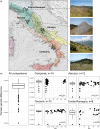Migration without interbreeding: Evolutionary history of a highly selfing Mediterranean grass inferred from whole genomes
- PMID: 34601787
- PMCID: PMC9298040
- DOI: 10.1111/mec.16207
Migration without interbreeding: Evolutionary history of a highly selfing Mediterranean grass inferred from whole genomes
Abstract
Wild plant populations show extensive genetic subdivision and are far from the ideal of panmixia which permeates population genetic theory. Understanding the spatial and temporal scale of population structure is therefore fundamental for empirical population genetics - and of interest in itself, as it yields insights into the history and biology of a species. In this study we extend the genomic resources for the wild Mediterranean grass Brachypodium distachyon to investigate the scale of population structure and its underlying history at whole-genome resolution. A total of 86 accessions were sampled at local and regional scales in Italy and France, which closes a conspicuous gap in the collection for this model organism. The analysis of 196 accessions, spanning the Mediterranean from Spain to Iraq, suggests that the interplay of high selfing and seed dispersal rates has shaped genetic structure in B. distachyon. At the continental scale, the evolution in B. distachyon is characterized by the independent expansion of three lineages during the Upper Pleistocene. Today, these lineages may occur on the same meadow yet do not interbreed. At the regional scale, dispersal and selfing interact and maintain high genotypic diversity, thus challenging the textbook notion that selfing in finite populations implies reduced diversity. Our study extends the population genomic resources for B. distachyon and suggests that an important use of this wild plant model is to investigate how selfing and dispersal, two processes typically studied separately, interact in colonizing plant species.
Keywords: flowering time; heterozygosity; population structure; seed dispersal; selfing.
© 2021 The Authors. Molecular Ecology published by John Wiley & Sons Ltd.
Conflict of interest statement
The authors declare no conflict of interest.
Figures





References
-
- Baker, H. G. (1955). Self‐compatibility and establishment after “long‐distance” dispersal. Evolution, 9(3), 347–349. 10.2307/2405656 - DOI
-
- Beckman, N. G. , Aslan, C. E. , Rogers, H. S. , Kogan, O. , Bronstein, J. L. , Bullock, J. M. , Hartig, F. , HilleRisLambers, J. , Zhou, Y. , Zurell, D. , Brodie, J. F. , Bruna, E. M. , Cantrell, R. S. , Decker, R. R. , Efiom, E. , Fricke, E. C. , Gurski, K. , Hastings, A. , Johnson, J. S. , … Zambrano, J. (2020). Advancing an interdisciplinary framework to study seed dispersal ecology. AoB PLANTS, 12(2), 1–18. 10.1093/aobpla/plz048 - DOI - PMC - PubMed
-
- Blasi, C. , Capotorti, G. , Copiz, R. , Guida, D. , Mollo, B. , Smiraglia, D. , & Zavattero, L. (2014). Classification and mapping of the ecoregions of Italy. Plant Biosystems, 148(6), 1255–1345. 10.1080/11263504.2014.985756 - DOI
Publication types
MeSH terms
Grants and funding
LinkOut - more resources
Full Text Sources
Miscellaneous

